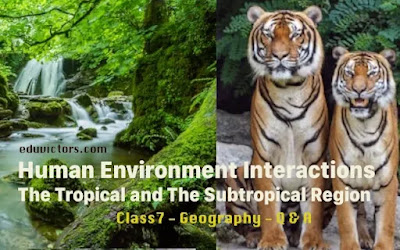Chapter 8: Human-Environment Interactions: The Tropical and The Subtropical Region - Questions and Answers (Part-2)
Class 7 - Subject: Social Science - Our Environment
For NCERT solutions and MCQs, you see the Part-1 post.
Q1. The Amazon River Basin lies near to which circle of latitude?
Answer: Equator.
Q2. Who discovered the Amazon river?
Answer: Amazon River was discovered by a Spanish explorer, Vicente Yanez Pinzon.
Q3. Through which countries does the Amazon river pass through?
Answer: The Amazon River basin drains portions of Brazil, parts of Peru, Bolivia, Ecuador, Columbia and a small part of Venezuela.
Q4. What type of climate is found in the Amazon basin?
Answer: The Amazon basin stretches directly on the equator and is characterized by a hot and wet climate throughout the year. There are heavy rainfall and high humidity.
Q5. What are tributaries?
Answer: These are small rivers that join the main river.
Q6. Name the rivers that together form the largest delta in the world.
Answer: The Ganga and Brahmaputra rivers together form the largest delta in the world.
Q7. List any five major cities that are found in the Ganga-Brahmaputra plains.
Answer: The Ganga-Brahmaputra plain has several big towns and cities like Allahabad,
Kanpur, Varanasi, Lucknow, Patna and Kolkata.
Q8. What are the major cities located on the river Ganga?
Answer: Major Cities located on the banks of River Ganga:
- Dev Prayag
- Rishikesh
- Haridwar
- Kanpur
- Pryagraj (Allahabad)
- Varanasi
- Patna
Q9. Write a short note on the climate of the Amazon Basin.
Answer:
① The climate of the Amazon Basin is characterised by hot and wet climate throughout the year
② Both day and night and almost equally hot and humid. It rains almost every day.
③ The day temperatures are high with very high humidity. At night the temperature goes down but the humidity remains high.
Q10. The Ganga-Brahmaputra Basin has a varied topography. How does it affect the distribution of population there?
Answer:
① The basin area has a varied topography. As a result, the distribution of the population is not even everywhere in the area.
② The mountain areas with steep slopes have inhospitable terrain. Therefore less number of people lives in the mountain area of the Ganga-Brahmaputra basin.
③ The plain area provides the most suitable land for human habitation. Therefore, the density of the population of the plains is very high.
Q11. How is tourism an important activity in the Ganga-Brahmaputra basin?
Answer:
① The Ganga-Brahmaputra plain has several big towns and cities, such as Allahabad, Kanpur, Varanasi, Lucknow, Patna and Kolkata.
② All these places are important from the tourist point of view. Taj Mahal on the bank of the river Yamuna in Agra is a famous tourist place. Allahabad is situated on the confluence of the river Ganga and Yamuna. Several people visit this place every day to have a holy dip in it. Buddhist stupas in Uttar Pradesh and Bihar, Lucknow with its Imambara.
③ Assam with Kaziranga and Manas with wildlife sanctuaries are some other places in the basin where people from different parts of the country and abroad go with great enthusiasm.
Q12. How can you say that the life of the people of the Amazon basin is changing?
Answer:
① Time flies by at a breakneck pace. As a result, people's lifestyles have changed all over the world. People's lives in the Amazon basin are likewise changing, though not at a rapid pace. It used to be difficult to go to the centre of the forest.
② The Trans Amazon highway opened in 1970, making all sections of the rain forest accessible. Aircraft and helicopters are also employed to get to other locations.
③ The indigenous peoples were pushed out of their homes and forced to relocate.
👉See Also:
Ch 6 Natural Vegetation and Wildlife
Ch7 Human Environment - Settlement, Trasport and Communication (NCERT Solution)
Ch8 Human-Environment Interactions: Tropical and Subtropical Region (NCERT Solutions)
Ch 8 - Human-Environment Interactions: Tropical and Subtropical Region (Assignment)
Ch9 Life in Temperate Grasslands (NCERT Solutions)
Ch10 Life in deserts (NCERT Chapter Answers)

No comments:
Post a Comment
We love to hear your thoughts about this post!
Note: only a member of this blog may post a comment.